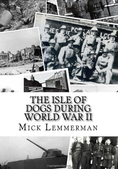Sir John McDougall Gardens is shown here in a 1986 aerial photo.
Visible north and south of the park are some of the last vestiges of the industry which once dominated the Isle of Dogs riverfront as can be seen in this 1920s view of more or less the same area:
The area was severely damaged during WWII and a 1950 map shows a lot of white space where sheds and factories once stood. Surprisingly, The Union pub (informally known as The Pin & Cotter, or just The Pin) managed to survive the war intact while nearly all the buildings around it were destroyed.
As early as 1954 plans were being made to turn this area into a public open space (to complement the housing estate planned for the other side of Westferry Road, the later Barkantine Estate). The LCC invited Poplar Borough Council to suggest a name for the park, and the Council proposed that it be named “Glengall Park”.
Although “Glengall Park” was a logical name for the park, it was not chosen. Instead the park was named after a politician who had represented Poplar in the past: John McDougall, one of five sons of the Manchester flour merchant Alexander McDougall, founder of McDougall’s Flour. John was responsible for setting up the firm’s business in Millwall Docks.

Sir John McDougall (1844-1917); City of London Corporation; http://www.artuk.org/artworks/sir-john-mcdougall-18441917-51793
Wikipedia:
John McDougall and his brothers had been encouraged by their father to engage in charitable activities, and John eventually left the family business in 1888 to become a local councillor, focusing in particular on lunatic asylums and drains.
He was a member of the Progressive Party and was elected to London County Council, representing – with Will Crooks – the Tower Hamlets district of Poplar from 1889 to 1913. He was elected chairman of the LCC 1902-03, and, on 26 June 1902, it was announced he would be knighted as part of the Coronation Honours of King Edward VII, the knighthood being conferred in a ceremony on 24 October 1902.
In about 1960, demolition started of some firms, but progress was slow and much of the land remained as wasteland for the first half of the decade – a great playground for local kids, and land which also featured in a couple of scenes from the 1964 film, Saturday Night Out, including an aerial view in the closing credits.
Sir John McDougall Gardens were opened in 1968, and local children were involved in the planting of trees.
At this time, there was still no footbridge connecting the park to the Barkantine Estate. I can’t imagine there were no plans to build a bridge – perhaps its construction was simply taking too long – but I do recall there were protests about the lack of a bridge, when it was necessary to cross the busy Westferry Road to get to and from the park.
The following photo shows the bridge under construction (it was opened in 1969). It also shows the original Tooke Arms pub, shortly before it was demolished and a new version was built a few yards to the north (to the left of the footbridge when viewed from this angle).

1970. Photo: London Metropolitan Archives (https://www.londonpicturearchive.org.uk/view-item?i=278032)
The little trees grew into larger trees, but the park didn’t change that much in the following couple of decades.

Circa 1980. Photo: Gary O’Keefe, probably checking on one of the trees he helped to plant more than ten years earlier.
Around 1990, the park was redesigned by the LDDC and now has more greenery than previously.
The London Borough of Tower Hamlets managed to misspell Sir John’s name at some stage (a mistake since corrected I believe).
Mind you, there’s nothing new about that. The memorial plaque affixed to the foot tunnel building on its opening in 1902 misspells his name too.
I must go in the park one day – I must admit to have never visited it, I’ve only whizzed by on the top deck of a 277 bus. However, I’m not on the Island that much these days, and tend to spend most of my time in the George or Ferry House (my old bones and muscles won’t be happy with slides and swings).



















Thank you for posting all this interesting information. It is surprising to see that some of the structures built near/in the park are unchanged since 1968. Thank you again.
And…… thank you for reading (and commenting)
Mick Lemmerman, another very interesting bit of history you have brought to the attention of all us “old” islanders plus the new islanders who have moved to the island since it’s regeneration.
The picture of the kids playing in the park in front of the original Tooke Arms is personal to me as it looks like the park is where 272 Westferry Road stood; it was my nans house Mrs Flo Wilkins.
I lived in Malabar Street and we were moved out for the regeneration. Most of my family lived in the area in Maria St, Janet St, Westferry Rd, plus Tooke St.
When I was 9/10 I worked with my cousin who drove for Cubitt Town transport who had a contract to deliver McDougalls flour around London.
Thanks, Alan.